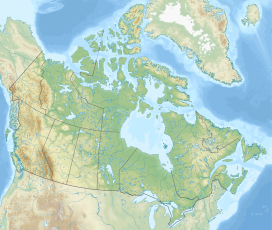
Mount Hector is a 3,394-metre (11,135-foot) mountain summit located in the Bow River valley of Banff National Park, in the Canadian Rockies of Alberta, Canada. The mountain was named in 1884 by George M. Dawson after James Hector, a geologist on the Palliser expedition. The mountain is located beside the Icefields Parkway, 17 km (11 mi) north of Lake Louise.

Mount Galwey is a mountain located north of Blakiston Creek in Waterton Lakes National Park, Alberta, Canada. The mountain was named in 1934 after Lt. Galwey, who was an astronomer for the International Boundary Commission.
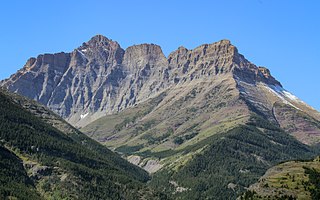
Mount Blakiston is a mountain in the southwestern corner of Alberta, Canada and the highest point within Waterton Lakes National Park. The mountain is situated in the Clark Range, north of Lineham Creek and south of Blakiston Creek. Blakiston's closest neighbours include Mount Hawkins 2,685 m (8,809 ft) directly to the west along a connecting ridge and Mount Lineham 2,728 m (8,950 ft) to the south.

Forum Peak is a summit located on the border of Alberta and British Columbia on the Continental Divide. It is the southernmost mountain in the Canadian Rockies, situated only 500 metres north of the Canada–United States border. It was named after Forum Lake below the mountain. It is visible from the end of Highway 5 at Cameron Lake, which is within Waterton Lakes National Park, and the mountain is on the park's southwest border.

Mount Alderson is a 2,692-metre (8,832-foot) summit located in Waterton Lakes National Park, in the Canadian Rockies of Alberta, Canada. Its nearest higher peak is Mount Custer, 8.0 km (5.0 mi) to the southwest. Mount Richards is situated 2.0 km (1.2 mi) to the southeast, and Bertha Peak is to the immediate northeast.
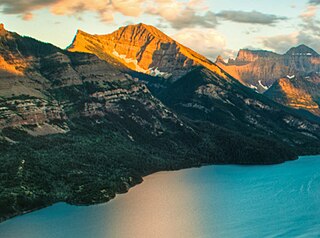
Mount Boswell is a 2,454-metre (8,051-foot) summit located in Waterton Lakes National Park, in the Canadian Rockies of Alberta, Canada. It is situated along the east shore of Waterton Lake, one kilometre north of the Canada–United States border. Its nearest higher peak is Miche Wabun Peak, 5.0 km (3.1 mi) to the southeast.
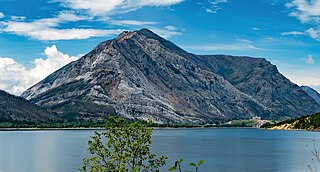
Mount Crandell is a 2,381-metre (7,812-foot) mountain summit located in Waterton Lakes National Park, in the Canadian Rockies of Alberta, Canada. It is situated immediately north of the Waterton townsite. Its nearest higher peak is Bertha Peak, 2.94 km (1.83 mi) to the south-southwest.

Dragon Peak is a 2,880 metres (9,450 ft) mountain summit located in the Athabasca River valley of Jasper National Park, in the Canadian Rockies of Alberta, Canada. Situated southeast of Mount Christie and Brussels Peak, Dragon Peak can be seen from the Icefields Parkway. The first ascent of the mountain was made in 1979 by D. Waterman. Dragon Peak was named in 1921 by Arthur O. Wheeler on account of a dragon-shaped rock formation. The mountain's name was officially adopted in 1935 by the Geographical Names Board of Canada.

Mount Dungarvan is a 2,575-metre (8,448-foot) mountain summit located in Waterton Lakes National Park, in the Canadian Rockies of Alberta, Canada. Its nearest higher peak is Cloudy Peak, 2.8 km (1.7 mi) to the west.

Haddo Peak is a summit in Alberta, Canada. Haddo Peak is located in the Lake Louise area of Banff National Park.

Mount Richards is a 2,377-metre-elevation (7,799-foot) mountain summit located in Waterton Lakes National Park, in the Canadian Rockies of Alberta, Canada. It is situated just north of the Canada–United States border, with the south footing of the mountain at Boundary Creek just within Glacier National Park of the United States. Its nearest higher peak is Mount Alderson, 2.0 km (1.2 mi) to the northwest. Bertha Lake and Bertha Peak are situated immediately to the north.

Vimy Peak is a 2,385-metre (7,825-foot) summit located in Waterton Lakes National Park, in the Canadian Rockies of Alberta, Canada. It is set along the east shore of Waterton Lake on the opposite side from Waterton Park townsite. It is situated 5.4 km west of Sofa Mountain, and the nearest higher neighbor is Arras Peak, 3.1 km (1.9 mi) to the southeast. Vimy Peak anchors the northern end of Vimy Ridge, which stretches three kilometers to Arras Peak anchoring the southern end.

Mount Morrison is a 2,765-metre (9,072-foot) mountain summit located in the upper Spray River Valley of southern Banff National Park, in the Canadian Rockies of Alberta, Canada. Mount Morrison in not visible from any road in Banff Park, however, it can be seen from Alberta Highway 742, also known as the Smith-Dorrien/Spray Trail in Kananaskis Country. Mount Morrison's nearest higher peak is Mount Turner, 1.8 km (1.1 mi) to the north.

Bertha Peak is a 2,454-metre (8,051-foot) mountain summit located in Waterton Lakes National Park, in the Canadian Rockies of Alberta, Canada. It is situated behind the Waterton townsite. Its nearest higher peak is Mount Alderson, 2.0 km (1.2 mi) to the southwest. Bertha Lake lies at the southern foot of the peak, with Mount Richards on the opposite side of the lake. Mount Crandell lies to the north.

Marvel Peak is a 2,708-metre (8,885-foot) mountain summit located in the southern tip of Banff National Park, in the Canadian Rockies of Alberta, Canada. Marvel Peak is situated in the Blue Range, three kilometers from the Continental Divide, and not visible from any road. Marvel Peak's nearest higher peak is Wonder Peak, 3.29 km (2.04 mi) to the north-northwest.

Sofa Mountain is a 2,515-meter (8,251-foot) summit located in Waterton Lakes National Park, in Alberta, Canada. It is part of the Lewis Range which is a subset of the Canadian Rockies, and is the easternmost mountain in the Canadian Rockies, as well as the park. It is situated 5.4 km (3.4 mi) east of Vimy Peak, and the nearest higher neighbor is Crypt Peak, 4.6 km (2.9 mi) to the southwest. Topographic relief is significant as the north aspect rises over 1,220 meters (4,000 feet) above Middle Waterton Lake in approximately six kilometers.

Mystic Peak is a mountain summit in the Canadian Rockies of Alberta, Canada.
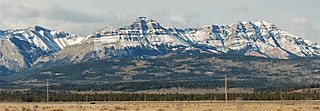
Association Peak is a 2,362-metre (7,749 ft) mountain summit located in Alberta, Canada.

Marmot Mountain is a 2,608-metre (8,556-foot) mountain summit located in Alberta, Canada.
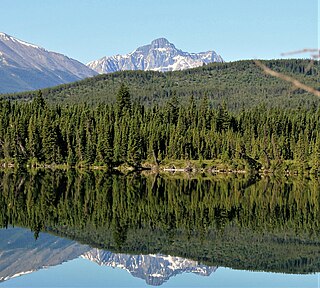
Roche Noire is a 2,920-metre (9,580 ft) mountain located in Alberta, Canada.


